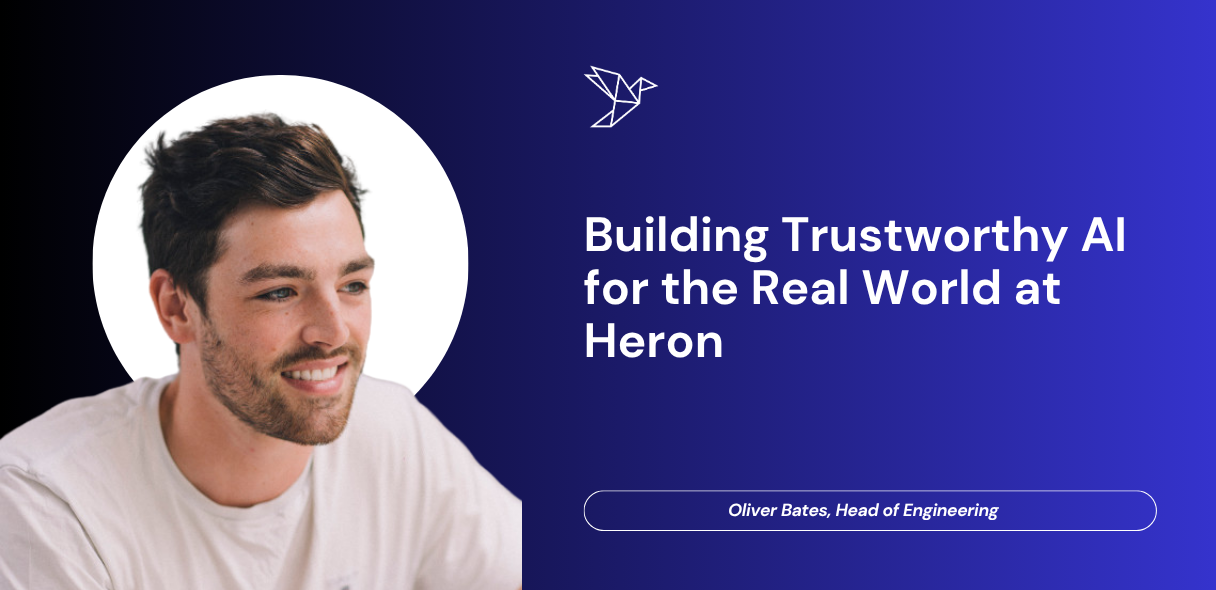We’re in the early days of the AI boom—but at Heron, this isn’t new. We’ve spent the last four years building production systems that insurers, lenders, and underwriters rely on 100,000 times a day. While much of the industry is still experimenting, we’ve already been through the hard parts—deploying real AI, at scale, in high-stakes workflows.
And in that world, the bar is higher. Flashy doesn’t cut it. Trustworthy does.
The deeper we’ve gone into real-world document workflows, the clearer it’s become: LLMs are not a product. A chatbot wrapper won’t help when you're ingesting hundreds of complex documents and making decisions that move real money. Accuracy isn’t enough. You need context, reasoning, and a system that knows when to flag what’s wrong.
Why Most AI Systems Break in the Real World
Most AI systems break because they’re built for clean inputs and happy paths. Real-world workflows are messier. It’s one thing to extract a name from a form. It’s another to parse a 98-page bank statement, cross-check it against a tax return, and flag anomalies that only make sense in context.
That’s where most teams go wrong—they treat AI as output generation. We treat it as judgment at scale: automating the kind of reasoning a human analyst or underwriter would do, but across thousands of cases.
At Heron, we don’t just extract data—we prove it’s right. Our customers are making real decisions: Should I insure this fleet? Approve this loan? Escalate this fraud flag? The bar isn’t 80%, or even 95%. It’s 99%—with a clear audit trail of why.
Building for 99% Accuracy Isn’t Magic. It’s Infrastructure.
When we say we’re 99% accurate on bank statement parsing, people assume we just fine-tuned a better model. The truth is: model performance is only part of the story.
Our system learns and improves as it sees more documents—but raw scale alone doesn’t guarantee reliability. What makes the difference is the validation infrastructure we’ve built around the models, checking their outputs at every level:
- Field-level checks: Does this extracted value look like a valid dollar amount, date, or routing number? Is the number formatted correctly? Is it consistent with the rest of the page?
- File-level reconciliation: For documents like bank statements, can we reconcile them end-to-end? Starting balance + transactions = ending balance? If not, something’s off.
- Submission-level validation: When a customer uploads multiple documents—say, a bank statement, a tax return, and a balance sheet—do the numbers line up across all of them? Any contradictions are flagged before they become underwriting risks.
And crucially, our backtesting infrastructure runs automated regression tests on historical submissions across 80+ document types every time we update a parser—so we catch regressions before they reach production.
We’ve also built something we’re especially excited about: Judge-in-the-Loop (JITL).
- Judge-in-the-Loop (JITL): Our internal QA engine captures expert reviewer logic in a scalable, auditable system. It doesn’t just say something looks off—it explains why. “This number doesn’t reconcile.” “This liability contradicts the tax return.” It mimics how a human reasons—and makes that thinking transparent.
That explainability is essential if you’re serious about building trustworthy AI. You can’t just output a result—you have to show your work. JITL doesn’t just build trust. It earns it—line by line, decision by decision.
What Trust Actually Means in AI
Accuracy is important. But trust is deeper.
Trust means knowing when you’re right—and knowing when you’re not. It means designing systems that can detect their own blind spots, flag inconsistencies, and explain their decisions.
LLMs are inherently non-deterministic. Run them twice on the same input and you might get two different answers. That’s fine in a playground. It’s a problem in production.
So at Heron, trust isn’t about perfect answers—it’s about structured defensiveness. Knowing the edges. Understanding context. Designing systems that raise their hand when something doesn’t add up. And building checks that catch those moments—before the customer ever sees them.
Why Not Just Build It In-House?
We often get asked: “Why not just let GPT-4 do it?”
In theory, yes. But you’re not just building a prompt. You’re building: a parser, a feedback loop, a validation system, a monitoring dashboard, an accuracy benchmarking suite, a team of QA analysts, a reasoning engine, and a fallback architecture.
…and even if you did all that, you’d still need to run it across millions of documents, constantly improve it, handle edge cases from a dozen verticals, and watch for failure modes you haven’t even seen yet.
At Heron, we’ve already done the hard engineering: layered systems, end-to-end validation, model fallback logic, and real-world backtesting at scale. We’re not just parsing files—we’re delivering decisions that hold up under scrutiny.
That’s why we designed our architecture to be layered and predictable:
- Lightweight models handle the common case—the top 8 banks cover 70% of our volume, and we’ve optimized fast parsers for them.
- Stronger models catch the long tail—weird formats, edge cases, and outliers.
- Determinism checks keep it sane—we reconcile totals, surface inconsistencies, and flag anything that doesn’t add up.
This hybrid approach gives us the best of both worlds: fast and cheap for the 70%, powerful and cautious for the 30%.
This hybrid approach gives us what most teams can’t deliver: speed for the 70%, caution for the 30%, and reliability across the board.
We’ve built the infrastructure so you don’t have to. And we’re just getting started.
Where This Is Headed
The future of AI isn’t field extraction. It’s reasoning—systems that correlate, question, and explain their outputs.
At Heron, we’re building exactly that. Not just smarter models, but the infrastructure around them: validation layers, fallback logic, audit trails, and systems that know when to say "this doesn’t look right."
We’re deploying this in industries where most AI teams won’t go: insurance, lending, compliance. Domains with messy inputs, high stakes, and zero tolerance for silent errors. That’s where trust matters most—and where the opportunity is greatest.
And we're not chasing benchmarks. We're designing AI that holds up in the real world—100,000 times a day, across millions of documents, with the proof to back it up.


